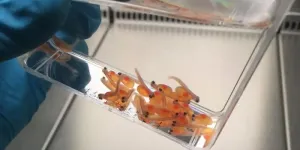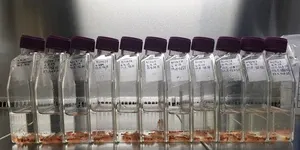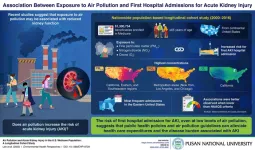(Press-News.org) Researchers, including from NTNU, are breeding bacteria-free fish fry. This pursuit is more important than you might think.
“We’re managing to keep the fry bacteria-free for up to 12 weeks after the eggs hatch,” says Ingrid Bakke. She is a professor at NTNU’s Department of Biotechnology and Food Science.
This step has now helped researchers on the trail to figuring out how bacteria and fish affect each other. Understanding their interaction could one day also lead to a method for preventing the fish from becoming ill and, although still a long way off, could be good news for the fishing industry, our future food supply – and not least for the fish themselves.
The researchers have studied how bacteria affect the growth, genes and mucous membranes of the fish.
But first a little about the bacteria in your body.
Trillions of bacteria
Bacteria obviously affect our health, but not only in a negative way.
As long as we are inside our mother's womb, we live protected and perhaps even germ-free, but that ends as soon as we are born. A human body normally contains many trillions of bacteria – that’s a number followed by 15 zeros. The same applies to other living organisms.
“Many of our bacteria are necessary for the human body to function. They’re necessary for the development of our immune system, and they contribute to digestion and increase the energy value of the food we eat. They protect against disease bacteria and produce vitamins that we need,” says Bakke.
All these functions and more help us to understand the importance of finding out more about how our bacterial friends work.
So how do researchers go about doing this research?
Knowledge from model systems
“A lot of what we know about how bacteria affect the host organism comes from experiments with model systems,” says Bakke.
What does that actually mean?
Model systems are living organisms that are easy to work with when studying biological processes. Most often, these species are easy to breed, cheap to maintain, have a reasonably long life cycle and have genetic traits that are easy to manipulate and other favourable features.
The specific characteristics researchers look for mostly depend on what they want to study. Zebrafish, banana flies and different kinds of mice and rats are among the most well-known species used as model systems.
Bakke and her colleagues have chosen a different species this time: Atlantic salmon.
Bacteria-free salmon fry
Salmon fry go through a stage where they live with a pouch called a yolk sac. This yolk sac supplies nutrition for the fry.
“We’ve come up with a model system where we can keep the yolk sac of the salmon fry bacteria free throughout the 12-week yolk sac phase,” says Bakke.
Fish are normally bacteria-free in the egg phase, but are colonized by bacteria as soon as they hatch. In contrast to all other salmon, these bred fry have no natural bacterial community.
The researchers breed the fish in a protected, germ-free environment, a standard method for making bacteria-free salmon fry. The research group has come up with an efficient and effective method that works for salmon eggs and fry.
“We surface treat the fish eggs to keep them bacteria free and keep the eggs, and later the fry, in bacteria-free water,” says Bakke.
Knowing how to create bacteria-free fry is necessary for the group to research them afterwards.
Salmon are like blank slates
The bacteria-free fry become almost like a kind of blank slate where the researchers can add the bacteria they want and then see exactly what happens, without interference from unknown bacteria.
“Bacteria-free model systems are generally important for understanding interactions between the bacteria and host,” says Bakke. “An example would be understanding how gut microbiota affect development and health in humans and other mammals.”
The microbiota consist of all the microorganisms found in our whole body or parts of our body.
“We can use bacteria and bacterial communities that we define, and investigate how both the host and bacteria are affected by living together,” says Bakke.
For example, the researchers can investigate which factors control the composition of bacterial flora in the fry. The researchers may then be able to influence the bacterial composition in the fish to avoid negative effects, or they can introduce good effects instead.
Salmon fry well suited for research
Zebrafish have been widely used as a model system in this context. But salmon fry have some characteristics that make them particularly suitable.
“We have large and well-developed fry, which makes them easier to study,” says Bakke.
The fry phase is long enough for the researchers to carry out several types of experiments. Since the fry obtain their nutrition from the yolk sac, the researchers don't need to add fish feed that could contain microorganisms that disturb the research results. As a bonus, the fry are nice to look at.
Bacteria found to affect skin mucus layer in salmon
To date, the researchers have published one article about their findings, but there are more to come. In the first article, they show that bacteria affect the protective skin mucus layer in the fish.
“The salmon have a protective mucus layer on the surface of their body. It appears that the composition of bacteria might affect the properties of this mucus layer,” says Bakke.
The fry that were not exposed to bacteria developed a thinner mucus layer on the outside of their bodies than the fry that were exposed to the researchers' specially selected bacteria, or bacteria from a lake.
The bacteria can also affect the fat reserves of the fish. The fry that received bacteria from a lake developed greater fat reserves.
“We needed interdisciplinary expertise to study the effect of bacteria on the fish's mucus layer. Researcher Sol Gómez de la Torre Canny was key in developing the germ-free model system with yolk sac fry,” says Bakke.
Researcher Catherine Taylor Nordgård, who is an expert in rheology, characterized the properties of the mucus layer that covers the fish.
Opens the door to treat fish
The goal of the researchers is to understand which mechanisms affect the composition of the bacterial communities that colonize the fish immediately after hatching.
“We’re looking at how the bacterial communities possibly protect against bacterial infections, and whether it’s possible to influence the early bacterial colonization of fry,” Bakke says.
Enabling such probiotic treatment would mean that researchers could add live microorganisms to the fish to achieve beneficial effects, such as better health and growth.
“But probiotic treatment on a large scale is still a long way off,” says Bakke.
The Norwegian product Stembiont is already available. This is a probiotic product intended for larger fish.
More research is needed for probiotic use on a larger scale. The research is being financed by the Research Council of Norway through FRIPRO funding.
Reference:
Gómez de la Torre Canny Sol, Nordgård Catherine Taylor, Mathisen Amalie Johanne Horn, Degré Lorentsen Eirik, Vadstein Olav, Bakke Ingrid. A novel gnotobiotic experimental system for Atlantic salmon (Salmo salar L.) reveals a microbial influence on mucosal barrier function and adipose tissue accumulation during the yolk sac stage. Frontiers in Cellular and Infection Microbiology, 12 2023 DOI:10.3389/fcimb.2022.1068302
END
Bacteria could make salmon healthier
Bacteria-free fish fry put researchers on the track to make fish more disease resistant.
2023-05-01
ELSE PRESS RELEASES FROM THIS DATE:
Pusan National University study suggests that hospital admissions for acute kidney injury may be linked to air pollution
2023-05-01
Acute kidney injury (AKI) is a clinical syndrome characterized by a decrease in kidney function. AKI is very common in the United States' Medicare population, particularly among hospital intensive care unit (ICU) admissions. Furthermore, AKI is associated with the incidence of end-stage renal disease, which eventually increases the burden of long-term care, higher health-care costs, and increased mortality.
In several instances, kidney diseases have been linked to air pollution exposure. Inhaling air pollutants, including gases like nitrogen dioxide (NO2), ozone (O3), and fine particulate matter (PM2.5) that remains suspended in ...
PLOS expands footprint in Europe with a publishing agreement in Italy
2023-05-01
SAN FRANCISCO —The Public Library of Science (PLOS) is pleased to announce an agreement with the University of Padua to facilitate unlimited publishing across all 12 PLOS titles with no fees for researchers. This agreement encompasses PLOS’ three innovative publishing models, ensuring researchers from the University of Padua to benefit from frictionless, fee-free publishing with PLOS. This agreement represents another in the Europe, following agreements in Germany, Sweden, Ireland and the UK (Jisc).
“We are excited to expand our footprint ...
Cognitive impairment after stroke is common, and early diagnosis and treatment needed
2023-05-01
Statement Highlights:
More than half of people who survive a stroke develop cognitive impairment within the first year after their stroke, and as many as 1 in 3 may develop dementia within 5 years.
The high risk of cognitive impairment and dementia after a stroke suggests early screening is essential for determining initial treatment, such as multidisciplinary care, cognitive rehabilitation or increased physical activity. It’s also important to assess stroke survivors for cognitive changes over time to offer appropriate treatment modifications and support for longer-term care.
Cognitive impairment after stroke may fluctuate, particularly ...
The best liquids to maximise antioxidant content in spinach smoothies
2023-05-01
Different market products give very different results when it comes to liberating the antioxidant lutein from spinach in smoothies. Researchers at Linköping University, Sweden, have examined 14 common dairy and plant-based products and found that only four of these increased lutein liberation. Compared to water, some drinks had a negative effect on the lutein content in spinach smoothies.
Most people know that spinach is good for your health. One substance found in, for instance, spinach and kale is lutein. Several experimental studies have shown that lutein can suppress processes linked to inflammation, and there is now ample research indicating ...
Slowing down in your old age? It may be a dementia warning sign.
2023-05-01
It’s generally accepted we will lose muscle strength and slow down as we age, making it more difficult to perform simple tasks such as getting up, walking and sitting down.
But new Edith Cowan University (ECU) research indicates this could also be a signal for another sinister health concern of ageing: late-life dementia.
To investigate the relationship between muscle function and dementia, the research teams from ECU’s Nutrition & Health Innovation Research Institute and Centre for Precision Health used data from the Perth Longitudinal Study of Ageing in Women to examine more than 1000 women with an average age of 75.
In collaboration with the ...
Air pollution exposure associated with increased risk of irregular heartbeat: Large study
2023-05-01
Does air pollution affect your heart? Acute exposure to air pollution was found to be associated with an increased risk of arrythmia — irregular heartbeat — in a large study of 322 Chinese cities published in CMAJ (Canadian Medical Association Journal) https://www.cmaj.ca/lookup/doi/10.1503/cmaj.220929.
The common arrhythmia conditions atrial fibrillation and atrial flutter, which can progress to more serious heart disease, affect an estimated 59.7 million people globally. Air pollution is a modifiable risk factor for heart disease, but the evidence linking it with ...
Study highlights risks for self-harm events in children and adolescents
2023-05-01
The United States is in the midst of a mental health crisis with rising rates of hospitalization for suicide and self-harm events among children and adolescents.
A study, “Characteristics Associated with Serious Self-Harm Events in Children and Adolescents,” set to be published in the June issue of Pediatrics, looked at how best to determine which children are at elevated risk for self-harm.
Researchers identified four separate profiles to help medical professionals better assess children at elevated ...
Researchers explore why some people get motion sick playing VR games while others don’t
2023-05-01
The way our senses adjust while playing high-intensity virtual reality games plays a critical role in understanding why some people experience severe cybersickness and others don’t.
Cybersickness is a form of motion sickness that occurs from exposure to immersive VR and augmented reality applications.
A new study, led by researchers at the University of Waterloo, found that the subjective visual vertical – a measure of how individuals perceive the orientation of vertical lines – shifted considerably after participants played a high-intensity ...
Life on land and water teeters between haves and have-nots
2023-04-30
In the race to make the world more livable for people and nature, progress on land outpaced successes in the seas, raising red flags that wealthier countries’ advantages may be upsetting a balance, a Michigan State University study shows.
Progress in oceans actually slowed after the United Nations member states adopted the 17 Sustainable Development Goals in 2015. That action aims to facilitate global partnerships among developed and developing countries in sustainable development.
So far, though, a new study in the open-access journal iScience reveals evidence that ...
Community health workers in early childhood well-child care for Medicaid-insured children
2023-04-30
About The Study: The intervention examined in this randomized clinical trial resulted in improvements in the receipt of preventive care services versus usual care for children insured by Medicaid by incorporating community health workers in a team-based approach to early childhood well-child care.
Authors: Tumaini R. Coker, M.D., M.B.A., of Seattle Children’s Research Institute in Seattle, is the corresponding author.
To access the embargoed study: Visit our For The Media website at this link https://media.jamanetwork.com/
(doi:10.1001/jama.2023.7197)
Editor’s ...
LAST 30 PRESS RELEASES:
Interaction of climate change and human activity and its impact on plant diversity in Qinghai-Tibet plateau
From addressing uncertainty to national strategy: an interpretation of Professor Lim Siong Guan’s views
Clinical trials on AI language model use in digestive healthcare
Scientists improve robotic visual–inertial trajectory localization accuracy using cross-modal interaction and selection techniques
Correlation between cancer cachexia and immune-related adverse events in HCC
Human adipose tissue: a new source for functional organoids
Metro lines double as freight highways during off-peak hours, Beijing study shows
Biomedical functions and applications of nanomaterials in tumor diagnosis and treatment: perspectives from ophthalmic oncology
3D imaging unveils how passivation improves perovskite solar cell performance
Enriching framework Al sites in 8-membered rings of Cu-SSZ-39 zeolite to enhance low-temperature ammonia selective catalytic reduction performance
AI-powered RNA drug development: a new frontier in therapeutics
Decoupling the HOR enhancement on PtRu: Dynamically matching interfacial water to reaction coordinates
Sulfur isn’t poisonous when it synergistically acts with phosphine in olefins hydroformylation
URI researchers uncover molecular mechanisms behind speciation in corals
Chitin based carbon aerogel offers a cleaner way to store thermal energy
Tracing hidden sources of nitrate pollution in rapidly changing rural urban landscapes
Viruses on plastic pollution may quietly accelerate the spread of antibiotic resistance
Three UH Rainbow Babies & Children’s faculty elected to prestigious American Pediatric Society
Tunnel resilience models unveiled to aid post-earthquake recovery
Satellite communication systems: the future of 5G/6G connectivity
Space computing power networks: a new frontier for satellite technologies
Experiments advance potential of protein that makes hydrogen sulfide as a therapeutic target for Alzheimer’s disease
Examining private equity’s role in fertility care
Current Molecular Pharmacology achieves a landmark: real-time CiteScore advances to 7.2
Skeletal muscle epigenetic clocks developed using postmortem tissue from an Asian population
Estimating unemployment rates with social media data
Climate policies can backfire by eroding “green” values, study finds
Too much screen time too soon? A*STAR study links infant screen exposure to brain changes and teen anxiety
Global psychiatry mourns Professor Dan Stein, visionary who transformed mental health science across Africa and beyond
KIST develops eco-friendly palladium recovery technology to safeguard resource security
[Press-News.org] Bacteria could make salmon healthierBacteria-free fish fry put researchers on the track to make fish more disease resistant.




